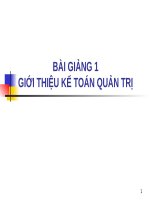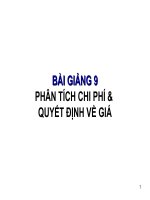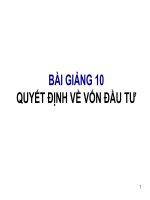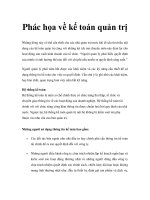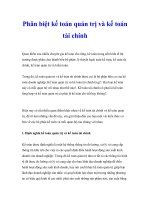ch08 Pricing Ke toan quan tri
Bạn đang xem bản rút gọn của tài liệu. Xem và tải ngay bản đầy đủ của tài liệu tại đây (1.9 MB, 71 trang )
Page
8-1
Pricing
Managerial Accounting
Fifth Edition
Weygandt Kimmel Kieso
Page
8-2
study objectives
1.
Compute a target cost when the market determines a
product price.
2.
Compute a target selling price using cost-plus
pricing.
3.
Use time-and-material pricing to determine the cost
of services provided.
4.
Determine a transfer price using the negotiated,
cost-based, and market-based approaches.
5.
Explain issues involved in transferring goods between
divisions in different countries.
Page
8-3
preview of chapter 8
Page
8-4
External
External Sales
Sales
The price of a good or service is affected by many
factors.
Illustration 8-1
Regardless of the factors involved, the price must
cover the costs of the good or service as well as
earn a reasonable profit.
Page
8-5
External
External Sales
Sales
To determine an appropriate price, a company must
have a good understanding of market forces.
Where products are not easily differentiated from
competitor goods, prices are not set by the
company, but rather by the laws of supply and
demand – such companies are called price takers.
Where products are unique or clearly distinguishable
from competitor goods, prices are set by the
company.
Page
8-6
Target
Target Costing
Costing
In a highly competitive industry, the laws of supply
and demand significantly affect product price.
No company can affect the price to a significant
extent so, to earn a profit, companies must focus
on controlling costs.
This requires setting a target cost that will provide
the company’s desired profit.
Page
8-7
SO
1 Compute a target cost when the market determines a product price.
Target
Target Costing
Costing
Target cost: Cost that provides the desired profit
on a product when the market determines a
product’s price.
Illustration 8-2
If a company can produce its product for the target
cost or less, it will meet its profit goal.
Page
8-8
SO
1 Compute a target cost when the market determines a product price.
Target
Target Costing
Costing
First, a company should identify its market niche
where it wants to compete.
Second, the company conducts market research to
determine the target price – the price the company
believes will place it in the optimal position for the
target consumers.
Third, the company determines its target cost by
setting a desired profit.
Last, the company assembles a team to develop a
product to meet the company’s goals.
Page
8-9
SO
1 Compute a target cost when the market determines a product price.
Target
Target Costing
Costing
KRC Phones, Inc. is considering introducing a
fashion cover for its phones. Market
research indicates that 200,000 units can be sold if the price
is no more than $20. If Fine Line decides to produce the
covers, it will need to invest $1,000,000 in new production
equipment. Fine Line requires a minimum rate of return of
25% on all investments. Determine the target cost per unit
for the cover.
The desired profit for this new product line is
$1,000,000 x 25% = $250,000
Each cover must result in profit of $250,000 / 200,000 units =
$1.25
Market price
Page
8-10
SO
- Desired profit= Target cost per unit
Solution
on notes
page
$20
$1.25
$18.75 pera unit
1 Compute
a target cost when
the market determines
product price.
Target
Target Costing
Costing
Review Question
Target cost related to price and profit means that:
a. Cost and desired profit must be determined
before selling price.
b. Cost and selling price must be determined
before desired profit.
c. Price and desired profit must be determined
before costs.
d. Costs can be achieved only if the company is
at full capacity.
Solution
Page
8-11
SO
on notes
page
1 Compute a target cost when the market determines a product price.
Cost-Plus
Cost-Plus Pricing
Pricing
In an environment with little or no competition, a
company may have to set its own price.
When a company sets price, the price is normally a
function of product cost: cost-plus pricing.
Approach requires establishing a cost base and
adding a markup to determine a target selling price.
Size of the markup (the “plus”) depends on the
desired return on investment for the product:
ROI = net income ÷ invested assets
Page
8-12
SO 2 Compute a target selling price using cost-plus pricing.
Cost-Plus
Cost-Plus Pricing
Pricing
In determining the proper markup, a company
must consider competitive and market conditions
Cost-plus formula is expressed as:
Illustration 8-3
Page
8-13
SO 2 Compute a target selling price using cost-plus pricing.
Cost-Plus
Cost-Plus Pricing
Pricing
Illustration: Cleanmore Products, Inc. is in the process
of setting a selling price on its new top-of-the-line,
3-horsepower, 16-gallon, variable-speed wet/dry
shop vacuum. The per unit variable cost estimates for
the new shop vacuum are as follows.
Illustration 8-4
Page
8-14
SO 2 Compute a target selling price using cost-plus pricing.
Cost-Plus
Cost-Plus Pricing
Pricing
In addition, Cleanmore has the following fixed costs per
unit at a budgeted sales volume of 10,000 units.
Illustration 8-5
Page
8-15
SO 2 Compute a target selling price using cost-plus pricing.
Cost-Plus
Cost-Plus Pricing
Pricing
Cleanmore has decided to price its new shop vacuum to
earn a 20% return on its investment (ROI) of $1,000,000.
Markup = 20% ROI of $1,000,000
Expected ROI = $200,000 ÷ 10,000 units = $20
Sales price per unit =
Page
8-16
Solution
on notes
SO
page
Illustration 8-6
2 Compute a target selling price using cost-plus pricing.
Cost-Plus
Cost-Plus Pricing
Pricing
Use markup on cost to set a selling price:
Compute the markup percentage to achieve a
desired ROI of $20 per unit:
Illustration 8-7
Compute the target selling price:
Illustration 8-8
Page
8-17
Solution
on notesSO
page
2 Compute a target selling price using cost-plus pricing.
Cost-Plus
Cost-Plus Pricing
Pricing
Limitations of Cost-Plus Pricing
Advantage of cost-plus pricing: Easy to compute.
Disadvantages:
Does not consider demand side:
Fixed cost per unit changes with change in sales
volume:
Page
8-18
Will the customer pay the price?
At lower sales volume, company must charge
higher price to meet desired ROI.
SO 2 Compute a target selling price using cost-plus pricing.
Cost-Plus
Cost-Plus Pricing
Pricing
Illustration: If budgeted sales volume for Cleanmore
Products was 8,000 instead of 10,000, Cleanmore’s
variable cost per unit would remain the same. However,
the fixed cost per unit would change as follows.
Illustration 8-9
Cleanmore’s desired 20% ROI now results in a $25 ROI
per unit [(20% x $1,000,000) / 8,000].
Page
8-19
SO 2 Compute a target selling price using cost-plus pricing.
Cost-Plus
Cost-Plus Pricing
Pricing
Cleanmore computes the selling price at 8,000 units as
follows.
Illustration 8-10
At 8,000 units, how much would Cleanmore mark up its
total unit costs to earn a desired ROI of $25 per unit.
Page
8-20
Solution
on notesSO
page
2 Compute a target selling price using cost-plus pricing.
Variable-Cost
Variable-Cost Pricing
Pricing
Alternative pricing approach:
Simply add a markup to variable costs.
Avoids the problem of uncertain cost information
related to fixed-cost-per-unit computations.
Helpful in pricing special orders or when excess
capacity exists.
Major disadvantage:
Managers may set the price too low and fail to
cover fixed costs.
Page
8-21
SO 2 Compute a target selling price using cost-plus pricing.
Variable-Cost
Variable-Cost Pricing
Pricing
KRC Air Corporation produces air purifiers.
Using a 45% markup percentage on total per
unit cost, compute the target selling price.
Page
8-22
Solution
on notesSO
page
2 Compute a target selling price using cost-plus pricing.
Variable-Cost
Variable-Cost Pricing
Pricing
Review Question
Cost-plus pricing means that:
a. Selling price = variable cost + (markup
percentage + variable cost).
b. Selling price = cost + (markup percentage X
cost).
c. Selling price = manufacturing cost + (markup
percentage + manufacturing cost).
d. Selling price = fixed cost + (markup
percentage X fixed cost).
Page
8-23
Solution
on notesSO
page
2 Compute a target selling price using cost-plus pricing.
Time-and-Material
Time-and-Material Pricing
Pricing
An approach to cost-plus pricing in which the
company uses two pricing rates:
One for the labor used on a job - includes direct
labor time and other employee costs.
One for the material - includes cost of direct
parts and materials and a material loading charge
for related overhead.
Widely used in service industries, especially
professional firms such as:
Public Accounting, Law, Engineering
Page
8-24
SO 3 Use time-and-material pricing to determine the cost of services
Time-and-Material
Time-and-Material Pricing
Pricing
Illustration: Assume the following data for Lake
Holiday Marina, a boat and motor repair shop.
Page
8-25
Illustration 8-11
SO 3 Use time-and-material pricing to determine the cost of services
